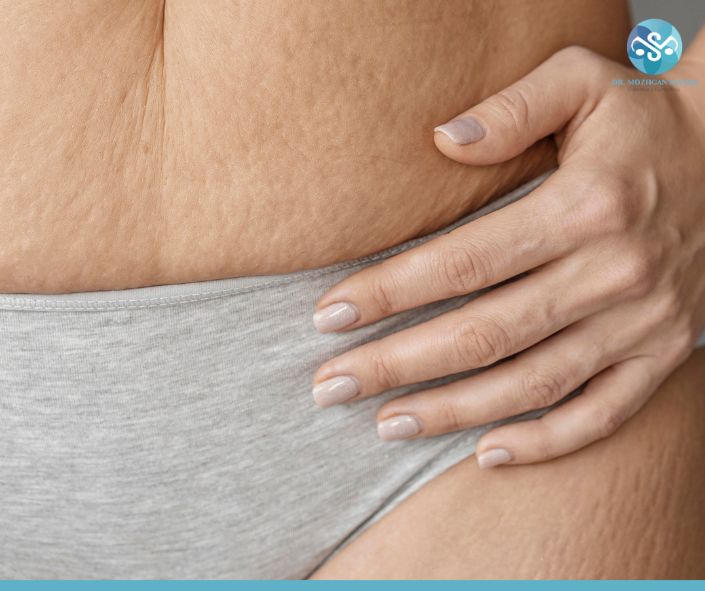Table of Contents
Dr. Mozhgan Sayyad, a reputed gynecologist from Dubai, shares six powerful treatments that help prevent intimate hyperpigmentation.
Understanding Hyperpigmentation in Intimate Areas
As the name suggests, intimate hyperpigmentation is skin darkening around the private parts, groin, and inner thighs. It’s so common that it’s even said that almost everyone experiences it. According to studies, hyperpigmentation results from the excess production of melanin, a pigment that delivers color to the skin.
At some point in our lives, we’ve all looked down and wondered why it’s dark down there. So, in this article, we brought in an expert, Dr. Mozhgan Sayyad, from Dubai. With over 25 years of invaluable experience, she is our source of everything we need to know about intimate hyperpigmentation.
Causes of Intimate Hyperpigmentation
- Age
Skin darkening with age is a natural phenomenon. As you age, the private parts transition in shape, color, tone, texture, and elasticity. As the fatty tissues become thinner, the thickness reduces, and the area shifts from light pink to dark brown.
- Hormones
One of the reasons why your area is darkening might be because of your hormones. According to countless studies, estrogen is an essential component of skin color. As you go through puberty, pregnancy, menopause, and other situations, estrogen can take a toll and darken your skin.
- Poor Ventilation
Without a doubt, good ventilation is key to a happy vagina and vulva! If you wear non-breathable and tight underwear, there’s a higher chance of intimate hyperpigmentation. This is because the lack of ventilation accumulates sweat and darkens the skin. So, to fight intimate hyperpigmentation, switch to cotton underwear and always remember to wash new garments before wearing them.
- Sweat
Sweating is also a common cause of intimate hyperpigmentation. People who sweat more often are more at risk of darkened skin around their private areas. If you sweat a lot, remember to [a] frequently clean yourself to prevent sweat building and [b] avoid scented soaps and other hygiene products that may irritate your skin.
- Friction
Friction is usually the result of poor ventilation and sweat. Did you know that when you wear tight clothes, and there’s skin friction, keratinization occurs? We know you might be thinking, ‘What on earth is keratinization?’ Well, it’s when keratinocytes [cells with keratin] produce higher layers of keratin in the topmost layer of skin. It also contains melanin which is a primary cause of pigmentation. Everyday activities that result in friction can lead to hyperpigmentation.
- Shaving
Regularly shaving or waxing your private parts is said to be another cause of intimate hyperpigmentation. That’s why you should try to shave less often, trim when necessary, and avoid scented products that irritate your skin. Instead of shaving or waxing, try laser removal.
- PCOS
Finally, women with polycystic ovary syndrome [PCOS] may also experience hyperpigmentation in their intimate areas. As there’s a hormonal imbalance with PCOS, melanin production is higher than usual. In such cases, someone can experience darkening of the skin in various parts of the body, including the intimate area.
Diagnosis
Unlike other skin conditions, intimate hyperpigmentation doesn’t require further tests; it can be identified visually.
Treatment
Although there’s no shame in it, you can choose from the following intimate area hyperpigmentation treatment if it causes you anxiety and embarrassment:
1. Tranexamic Acid
This lesser-known acid is an excellent way to battle hyperpigmentation. When applied topically, tranexamic acid helps to alter melanin production. Some of its benefits include:
- Strong skin barrier
- Lightened area and spots
- Lightened discoloration
If you’ve sensitive skin, always do a patch test before using it throughout the affected area. Potential risks associated with using the acid are dryness, irritation, flaking, and swelling.
How does Tranexamic Acid Work to Treat Hyperpigmentation?
A signature method of Dr. Mozhgan, she combined tranexamic injection and radio frequency to reduce hyperpigmentation to offer optimum results for her patients.
Tranexamic acid primarily stops the production of melanin. Melanin, the substance that imparts color to our skin, is produced by melanocytes, other specialized skin cells that produce pigment upon stimuli [like UV radiation, hormonal changes, and inflammation].
When taken topically or orally, tranexamic acid blocks the pathway for excess pigment production by targeting plasmin, an enzyme actively involved in melanin production. Plasmin is responsible for several activities that ultimately lead to the formation of melanin. By stopping the plasmin activity, tranexamic acid hinders melanin production, thus treating hyperpigmentation. Typically, positive results are visible after a few sessions.
2. Laser Treatment
Laser treatment is a cosmetic procedure designed to lighten dark private areas by targeting laser beams. This procedure usually takes between 45 minutes to an hour and is split into 3-5 recurring sessions depending on how light you want it to be. Here’s a summary of the laser treatment procedure:
- The area is cleaned and thoroughly disinfected
- Local anesthesia is administered to reduce any pain or discomfort
- The FemiLift laser is placed around the target area
- Laser beams from the device tackle the melanin & remove a thin layer of hyper-pigmented skin.
- In the end, a cooling cream is applied to relieve pain or discomfort.
3. Peeling Treatment
Another common and effective method to reduce intimate hyperpigmentation is peeling. According to the establishment you choose, there will be various peeling treatments to choose from. Some popular treatments are chemical peel, IPL skin rejuvenation, and fractional laser skin resurfacing.
If you choose to undergo a peeling treatment, here are a few important things to know. In chemical peeling, there’re three peels distinguished by their depths for you to choose from. They are:
- Light Peeling: A light peel that targets the outermost layer of the skin [epidermis].
- Medium Peeling: A peel that targets skin cells from the epidermis and upper-middle layer of the skin [dermis]
- Deep Peeling: A peel that targets skin cells from the epidermis and cells from the middle to the bottom layer of the dermis.
Depending upon the peel you choose, your treatment also changes.
4. Niacinamide
Niacinamide is a type of vitamin B3 that has shown favorable results in reducing hyperpigmentation of intimate areas. In fact, a clinical study conducted in 2002 found that Niacinamide significantly decreased hyperpigmentation after four weeks of use. Here’s how Niacinamide reduces hyperpigmentation:
- Stops Melanin Production: Similar to tranexamic acid, Niacinamide also inhibits melanin production on the skin.
- Stops Transfer of Pigment: Niacinamide can also stop the pigment transfer within the cells, thus preventing hyperpigmentation.
- Anti-Inflammatory Properties: It includes anti-inflammatory properties that reduce inflammation, which can contribute to the darkening of the skin.
- Antioxidant Properties: Niacinamide also contains antioxidant properties that protect the skin from radical damage.
5. Vitamin C
Vitamin C, or ascorbic acid, is a powerful antioxidant that has shown favorable results on hyperpigmentation. A study published in 2020 revealed that Vitamin C successfully lightened the skin by inhibiting the production of melanin and reducing inflammation, two factors contributing to hyperpigmentation. Vitamin C has several properties that help reduce hyperpigmentation. They are:
- Stops Melanin Production: Vitamin C has also shown favorable results in blocking melanin production.
- Antioxidant Properties: Vitamin C contains essential antioxidant properties that protect the skin from radical damage.
- Collagen Synthesis: Vitamin C is fundamental for producing collagen, a protein essential for skin health. Collagen reduces hyperpigmentation by improving skin texture and reducing dark spots.
6. Arbutin
Arbutin, a component extracted from the bearberry plant, is a common ingredient in most skincare products. Arbutin suppresses melanin activity which helps fight hyperpigmentation. The properties that make Arbutin a helpful treatment are:
- Stops Melanin Production: Arbutin blocks the activity of tyrosinase, an enzyme involved in melanin production. Since it stops tyrosinase, it helps reduce hyperpigmentation.
- Stops Transfer of Pigment: Arbutin inhibits the transfer of pigment within the skin cells, which thereby reduces the darkening of the skin.
- Anti-Inflammatory Properties: Arbutin has anti-inflammatory properties that can help reduce inflammation in the skin, which can contribute to hyperpigmentation.
Common Questions
Q1. What lifestyle changes can I make to prevent intimate hyperpigmentation?
Some lifestyle changes that can prevent hyperpigmentation include avoiding excessive sun exposure, using suitable sunscreen with high SPF, wearing protective clothes and hats during heat, avoiding smoking, maintaining a healthy diet, and managing stress.
Q2. Can intimate hyperpigmentation be genetic or inherited?
Of course, it can. Certain skin types are prone to hyperpigmentation, while some genetic disorders can also cause hyperpigmentation.
Q3. How long will it take to see positive results from intimate hyperpigmentation treatment?
The time varies depending on the severity of the condition and the type of treatment used. But typically, you can see positive results within the first several weeks or months.
Q4. Is my intimate hyperpigmentation signifying an underlying condition?
Hyperpigmentation can sometimes signify an underlying health condition like hormonal imbalance, liver disease, or certain autoimmune disorders. If hyperpigmentation doesn’t improve with treatment, seek medical help to rule out the possibilities.
Q5. How is hyperpigmentation different from other skin conditions like melasma or age spots?
Hyperpigmentation is a broad term that refers to any area of skin that’s darker than the rest. In the case of melasma and age spots, they’re very specific types of hyperpigmentation. Melasma is categorized by dark patches across the face, while age spots are small, flat, and dark spots that appear on hands/face/other areas when frequently exposed to the sun.
Conclusion
As you can see, intimate hyperpigmentation is common, and there’s absolutely nothing to be ashamed of. However, if it does cause you anxiety or embarrassment, speak to your gynecologist. There’re several helpful ways to brighten your intimate area. If you’re looking for hyperpigmentation treatments in Dubai, then you’ve come to the right place. With years of experience and knowledge, Dr. Mozhgan will help you feel beautiful and rejuvenated!
Book an Appointment





